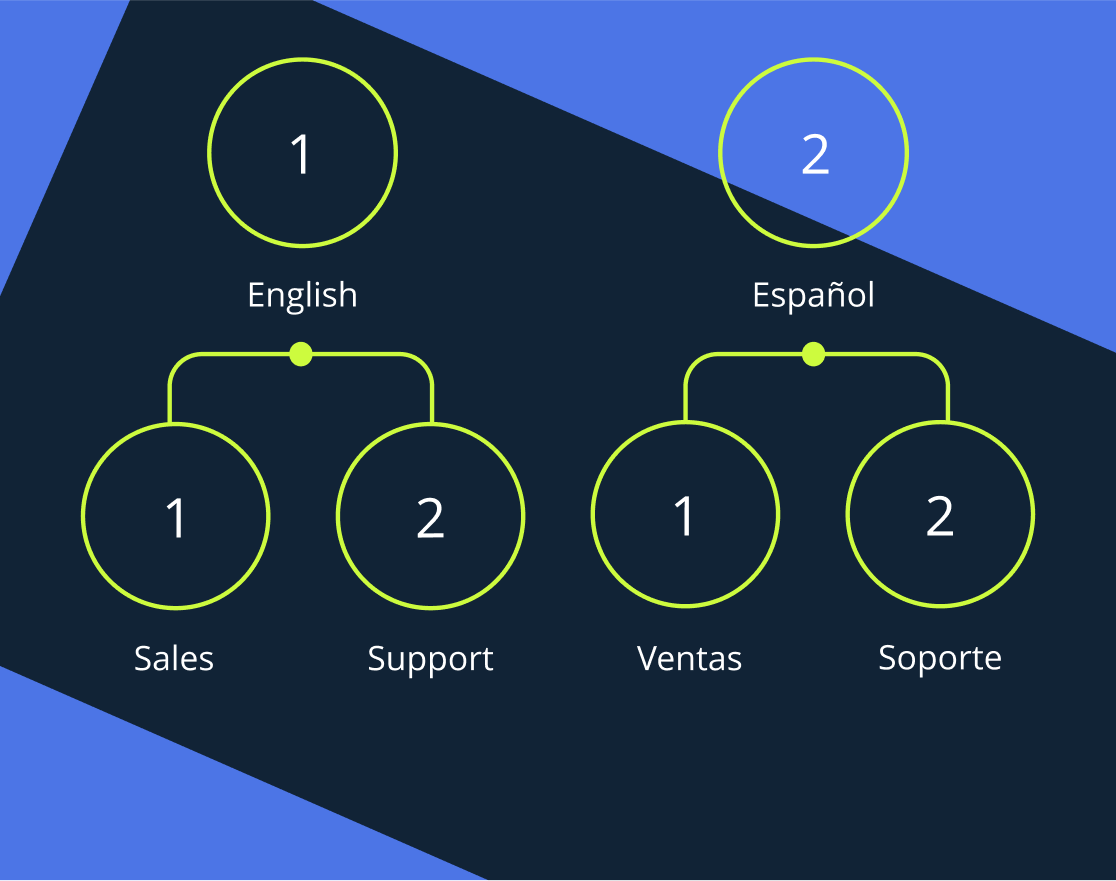Knowing every call’s outcome in your call center’s history feels like an obvious feature. Yet sometimes you have to really search for it.
Call dispositions provide a structured way to classify and analyze interactions. This article explores the key codes necessary for every business. These codes are fundamental for improving customer satisfaction, boosting agent performance, and guiding strategic decisions. Through systematic call management and detailed call disposition data analysis, businesses can meet a wide range of needs and improve their operations.
What is a call disposition?
A call disposition in contact centers is the classification of the outcome of a call, providing a brief summary of the interaction. This categorization is key to customer service and sales, enabling agents to document the nature of each call with specific labels or codes.
Organizations use this system to organize their communication processes, ensuring that important information is accurately captured and accessible for future reference. This practice aids in managing calls and analyzing customer interactions, helping in the improvement of service strategies and business operations.
Common call disposition examples
Here’s a table with a few common call disposition examples, selected to cover a wide range of scenarios encountered in daily operations. Each code is accompanied by a brief explanation:
| Tag | Explanation | Tag | Explanation |
|---|---|---|---|
| 1. Resolved | The issue or query was fully addressed during the call. | 11. Busy | The line was busy, indicating the call could not be connected at the time. |
| 2. Requires Follow-Up | Further action or information is necessary after the call. | 12. No Answer | The call was not answered, suggesting a need for a potential follow-up. |
| 3. Interested in Product | The caller showed interest in a product or service. | 13. Agent Abandoned | The call was ended by the agent before it was resolved, requiring review or follow-up. |
| 4. Not Interested | The caller indicated no interest in the offered product or service. | 14. Hang Up | The caller ended the call before any resolution could be reached, intentionally or unintentionally. |
| 5. Left Voicemail | A voicemail was left for the caller due to unavailability. | 15. Invalid Number | The dialed number was incorrect, leading to an unsuccessful call attempt. |
| 6. Appointment Scheduled | An appointment or meeting was arranged as a result of the call. | 16. Happy Client | The call ended with the client satisfied or happy with the service or information provided. |
| 7. Sale Closed | The interaction concluded with the sale of a product or service. | 17. Call Back Later | The caller requested to be contacted again at a more convenient time. |
| 8. Call Dropped | The call was disconnected before resolution could be achieved. | 18. Incorrect Number | The agent identified the number dialed as wrong, necessitating correction or removal from contact lists. |
| 9. Payment Processed | A payment was successfully made or processed during the call. | 19. Not Interested | The caller explicitly stated disinterest in the offer, product, or service. |
| 10. Customer Feedback Received | Feedback was provided by the customer, valuable for service or product improvement. | 20. Referral Generated | The call resulted in a referral to another potential customer or contact, expanding business opportunities. |
How does call disposition work?
The development of the call disposition function and its integration into customer service and sales strategies emerged from the growing need for systematic call management and data-driven decision-making in businesses. Initially, as companies began to recognize the value of detailed customer interaction records, there was a push towards creating a standardized method for categorizing and analyzing calls. This need was especially pronounced in industries with high volumes of customer interactions, such as telecommunications, banking, and retail. It is essential in customer service and sales, ensuring each call’s outcome is systematically recorded and categorized.
The process steps:
- Incoming call: The process starts with the system logging the receipt of a call.
- Call handling: Here, the call is either answered by an agent or managed by the system, for instance, by directing it to voicemail.
- Outcome identification: After the call ends, its outcome is determined, either automatically (system disposition) or manually by the agent (agent disposition).
- Selection: The agent selects the most appropriate option from a predefined list, enabling detailed categorization of the call outcome.
- Data recording: This involves recording the chosen option and relevant call details into a CRM system or call management software.
- Analysis and reporting: The final step involves analyzing the collected data to assess performance and inform strategies for improving future interactions.
Types of dispositions:

System
Built into the service, these are assigned automatically based on specific call outcomes, such as “Busy” or “No Answer.” These actions, although preset, can be modified to fit organizational needs. MightyCall, for example, offers the following options:
- Busy
- No answer
- Agent abandoned
- Hang up
- Invalid number
Agent
Outcomes manually selected by the agent after a call. These options, determined by supervisors, offer a customized method for classifying calls, ensuring solutions with call dispositions can meet the varied needs of their clients.
By combining system and agent tags, systems such as MightyCall will provide you with a detailed and adaptable system, allowing for customization to meet the specific needs of each client, thereby optimizing call management.
Using call dispositions in business operations
Call dispositions are instrumental in addressing specific operational tasks within customer service and sales departments. They facilitate a range of essential functions:
- Categorizing customer interactions: They allow for the systematic classification of each call’s outcome, providing clarity and order to customer communication logs.
- Highlighting training needs: By analyzing patterns in call outcomes, businesses can identify areas where customer service representatives require additional training or resources.
- Ensuring customer issues are tracked and resolved: Tags such as “requires follow-up” make sure that every customer issue is acknowledged and appropriately addressed in subsequent communications.
- Identifying sales opportunities: Disposition calls that indicate a customer’s interest in products or services help sales teams focus their efforts on promising leads.
- Assessing staff performance: The use of specific call tagging by agents offers insights into their handling of various call scenarios, enabling performance reviews and coaching opportunities.
- Organizing workload and responsibilities: This feature aids in the successfull distribution of calls across relevant departments or specialized teams based on the nature of the inquiry.
Explore how our service automates these tasks, improving the success of your operations and the satisfaction of your customers. Sign up and improve the organizational benefits of your call center with MightyCall.
schedule your personalized demo with our amazing team

Benefits of call dispositions
The essential advantage of call disposition becomes clear from the first moments of use. To customer service and sales processes within organizations, it helps to focus on clear improvements and straightforward outcomes. Here are the key benefits:
Improved customer satisfaction
Recording outcomes from customer interactions meticulously with tags helps call centers gain insight into customer needs. This leads to accurate and timely resolution of issues, increasing satisfaction, and building customer loyalty.
Higher agent output
Simplifying the recording process of call outcomes with sales disposition saves time for agents, reducing mistakes. This allows agents to manage more calls or dedicate extra time to complex queries, leading to better productivity.
Strategic insights
Analyzing sales-related call disposition data uncovers trends in customer interactions, agent performance, and common issues. These insights guide strategic decisions, improving training, staffing, and policies to better meet customer needs and speed up operations.
Directed sales strategies
Identifying potential leads through tags enables sales teams to concentrate efforts on individuals showing interest, thereby improving the chances of conversion and making sales processes more effective.
Detailed performance reviews
Evaluating agents becomes more objective with this feature, offering a clear perspective on their handling of different situations. This aids in identifying strengths and training needs, supporting professional development.
Fast call routing
Organizing calls by their outcomes through disposition in call centers helps in directing them to suitable departments or for necessary actions more promptly, reducing response times, and ensuring the right handling.
Reduced costs
The adoption of tags leads to operational success when it comes to handling the call volume, minimizing the need for repeated contacts and extensive follow-up. This results in saving time and resources, directly impacting the bottom line.
Better customer data quality
Using call disposition codes improves the quality of customer data collected, offering a more detailed and accurate customer profile. This enriched data supports more personalized customer service and targeted marketing strategies, furthering customer engagement and loyalty.
Improved compliance and reporting
Tags help in maintaining regulatory compliance by ensuring that all customer interactions are recorded and categorized according to industry standards. This systematic approach simplifies reporting and auditing processes, providing clear evidence of compliance and operational functionality.
Emotional intelligence training
This feature offers insights into the emotional aspects of customer interactions, enabling targeted training to improve agents’ empathy and communication skills. This approach not only improves customer service but also fosters a more emotionally intelligent work environment, deepening customer connections.
Lists of call disposition codes for managing inbound and outbound calls
Call disposition codes are critical for categorizing the outcome of both inbound and outbound calls, providing valuable insights into customer interactions and agent performance. These codes help in tracking the efficiency of communication efforts and in tailoring future strategies. Here are examples of codes commonly used for both types of calls.
For inbound calls
- Resolved: The caller’s issue was fully resolved during the inbound call.
- Transfer to department: The call was transferred to another department for specialized assistance.
- Follow-up required: The issue could not be resolved, necessitating a follow-up.
- Information provided: The caller was seeking information, which was provided.
- Complaint registered: The inbound caller made a complaint that was logged for further action.
- Service inquiry: The call was about inquiring about service details.
For outbound calls
- Interested: The contact expressed interest in the product/service.
- Not interested: The contact was not interested in the offering.
- Callback requested: The contact requested a call back at a later time.
- Voicemail left: Reached voicemail and left a message.
- Wrong number: The dialed number was incorrect.
- Sale closed: The call resulted in a sale.
These lists of outbound and inbound call disposition examples serve as a structured way to capture the outcomes of customer interactions, guiding agents in managing calls effectively and strategizing future communication.
How many call disposition codes should you use?
Determining the right number of codes is crucial for successful operations and customer support:
- Too few: Can oversimplify customer interactions;
- Too many: May complicate the categorization process and reduce speed.
- The ideal count: Depends on the complexity of your call center operations, the variety of calls handled, and the level of detail required for analytics and follow-up actions. Generally, a balanced range of 10 to 15 codes is recommended. This provides enough granularity to accurately describe different call outcomes without overwhelming agents or diluting the data’s usefulness. Adjusting this range to fit the specific needs and scale of your operations can further optimize your call management strategy.
Use cases
Call disposition tags significantly improve communication, customer service, and operational efficiency in diverse sectors. Below, we explore their application across various industries:
Healthcare
In healthcare, tags help manage patient interactions, covering appointments, inquiries, and urgent needs. Examples include:
- Appointment scheduled: Marks when a patient’s appointment is booked.
- Prescription inquiry: Used for calls regarding medication questions.
- Emergency escalation: For urgent calls needing immediate medical attention.
These inbound and outbound call disposition examples aid in prioritizing patient care and managing healthcare resources.
Sales
For sales teams, call disposition categories are key to managing leads and working on the conversion rates. Common uses include:
- Interested lead: Identifies leads showing potential interest.
- Follow-up needed: Indicates leads requiring more contact or information.
- Not interested: Identifies contacts with no interest, refining lead targeting.
This approach helps sales personnel concentrate on viable leads and refine their sales strategies.
Call centers
Call centers employ tags to categorize customer interactions and assess service levels. Examples include:
- Issue resolved: When a customer’s issue is addressed during the call.
- Call escalated: Marks calls transferred for higher-level support.
- Customer feedback: For calls primarily collecting customer opinions.
These tags help to evaluate service performance and guide improvements.
HR
HR departments use tags to organize employee inquiries, call disposition notes, benefits discussions, and recruitment processes. For instance:
- Job application received: Notes submission of a job application.
- Benefits inquiry: For questions about employee benefits.
- Interview scheduled: When an interview is arranged with a candidate.
These tags help HR manage recruitment and respond to employee needs in a timely manner.
Real estate
Real estate agents apply disposition codes to track client interactions, inquiries, and property viewings. Examples include:
- Property inquiry: When potential buyers or renters inquire about a property.
- Viewing scheduled: For arranging property viewings.
- Offer discussion: Used for calls involving property offer negotiations.
These tags enable real estate professionals to do follow-ups and prioritize tasks for closing deals.
Education
In the education sector, tags simplify communication between institutions, students, and parents. Examples include:
- Enrollment inquiry: When prospective students or parents call for information about courses or admission procedures.
- Financial aid discussion: Covers calls related to scholarships, grants, and tuition payments.
- Academic advising: For calls that involve guidance on course selection, career advice, or academic support.
These tags assist educational institutions in managing inquiries, providing information, and supporting student success.
Dispositioning calls in these areas supports improved management of customer interactions, insight into operations, and better resource allocation, highlighting the wide applicability and positive impact of this tool.
What challenges are associated with the call disposition list?
Using disposition codes in an organized list aims to improve customer service and sales workflows, yet certain challenges can arise. Below are three main issues encountered, with each followed by a practical solution.
Overcomplexity
A significant challenge is creating an excessive number of tags, which can overwhelm agents and lead to inconsistent application. This complexity can hinder the call disposition analytics and reduce system effectiveness.
Solution: Simplify the list by merging similar tags into broader categories that encompass the majority of call outcomes. Keeping the list updated and relevant through regular reviews helps maintain its usability.
Insufficient training
Contact center agents might not be adequately trained on the correct application of each tag, leading to inaccuracies in categorization. This inconsistency can distort data, impacting decision-making.
Solution: Offer thorough training programs that incorporate examples of call disposition and role-playing exercises. Ongoing education and feedback improve agents’ understanding and accuracy in using tags.
Rigidity
A call list that does not adapt to changing business or customer needs can become obsolete, reducing its utility.
Solution: Periodically reassess and adjust the list to align with new product offerings, customer queries, or market trends. Including agents in these discussions can provide insights into which tags are most beneficial and which may need modification or elimination.
By addressing these issues with thoughtful strategies, the utility of tag lists in customer interactions can be fully realized.
Integration with existing systems
Another issue is ensuring that the list of call disposition codes integrates well with other customer relationship management (CRM) systems and workflows. A lack of integration can lead to silos of data and failing processes.
Solution: Work closely with IT and system administrators to ensure that the tag list is fully compatible with existing systems. This can involve custom configurations or seeking software solutions designed for easy integration, facilitating a smoother workflow and more accurate data capture.
Call disposition best practices
Managing call center dispositions codes is crucial for improving customer service and gathering precise insights from call data. Below are essential tips for using codes, each explained in detail.
Update the list regularly
It’s vital to keep your call disposition meaning in tune with the current business operations, customer needs, and service offerings. An outdated list can lead to incorrect data collection and misinterpretation of customer interactions. Regular reviews ensure that your team has relevant and applicable codes, improving the accuracy of call logging and data analysis.
Continuous training for your team
All contact center team members should understand how to apply codes accurately. This includes knowing the meaning of each code and when to use them. Regular training updates on any changes to the list reinforce the importance of precise call logging, improving data quality, and the potential for better service.
Maintain a balanced number of codes
Having too many codes can confuse agents and result in inconsistent logging of call dispositions. Strive for a list that is detailed enough to cover all necessary outcomes but not so extensive that it becomes cumbersome. A well-balanced list promotes clarity and consistency in call categorization, making the collected data more useful.
Engage agents in the development process
Agents’ insights are invaluable in developing and refining call disposition lists, as they are the most familiar with the nuances of customer interactions. Their input can highlight which codes are essential and which are superfluous, ensuring the list is both practical and directly relevant to daily operations.
Analyze data and implement changes
Track of the outcomes of communications. Regular analysis of data derived from tags can uncover trends, evaluate agent performance, and better understand customer needs. Use these insights to inform strategic decisions, from identifying training opportunities to enhancing service processes. Implementing changes based on this analysis allows for continuous service optimization, aiming to meet and surpass customer expectations.
Ensure clear definitions and guidelines
Clear definitions and guidelines for each code are necessary to avoid confusion and ensure consistent application across all team members. Providing specific examples and scenarios where each code should be used can help agents make accurate decisions. This clarity aids in collecting reliable data for analysis, helping to measure agent performance and drive meaningful improvements in service and strategy.
Following these best practices helps businesses make the most of the call disposition feature, leading to better customer service, operational improvements, and insightful business decisions.
What to include in the call disposition report?
A call disposition report should include several elements for thorough analysis and effective action planning. Here’s what to include and the rationale:
- Total number of calls: Offers an overview of operational volume and workload.
- Types of tags used: Sheds light on the range of call outcomes, useful for spotting trends and improvement areas.
- Average call duration: Indicates service speed and customer satisfaction.
- Calls resulting in sales: Reflects on the success of sales tactics and agent performance.
- Calls requiring follow-up: Points out areas needing additional attention or customer re-engagement opportunities .
- Customer feedback calls: Provides insights into customer satisfaction and suggestions for product or service improvements.
- Agent-specific performance data: Helps in assessing individual agent performance via the specific call disposition datum and identifying training needs.
- Time of day/week analytics: Reveals peak call times and helps in staffing and resource allocation.
- Resolution rates: Measures the percentage of calls resolved on the first contact, indicating efficiency and effectiveness.
- Tags leading to conversions: Identifies which types of calls are most likely to result in sales, guiding sales strategy.
- Repeat call patterns: Tracks customers calling multiple times on the same issue, indicating potential areas for service improvement.
Incorporating these details provides a comprehensive picture of call center activities, aiding in focused improvements and strategic decisions.
Are you ready to implement call dispositions?
Adopting custom call disposition into your operational strategy can transform how you manage customer interactions and analyze performance. This concise overview outlines the essential benefits and best practices, demonstrating the value of tags in enhancing customer service, operational success, and strategic decision-making. Embracing tags offers a structured approach to capturing invaluable customer insights and driving continuous improvement.




























